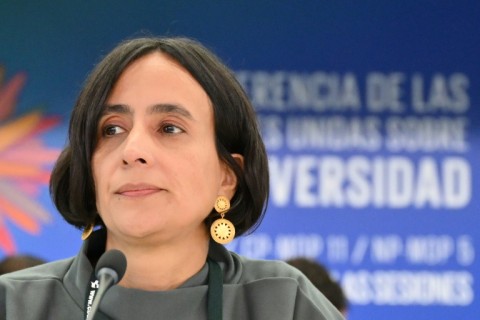
Wednesday, 23 April 2025
Skating comeback queen Liu says she can get even better for Olympics

Tuesday, 22 April 2025
Airtel to spot international spam calls; alert users in vernacular languages
Sunday, 13 April 2025
Post-apocalyptic 'The Last of Us' more timely than ever, say stars
Saturday, 5 April 2025
Sky announces 2,000 job cuts
Friday, 4 April 2025
World Club Cup winner to score up to $125 million prize money

Friday, 28 March 2025
India welcomes newest Rajasthan unit to the grid
 The site is home to two 700 MWe PHWRs (Image: screengrab from NPCIL video)
The site is home to two 700 MWe PHWRs (Image: screengrab from NPCIL video)Thursday, 27 March 2025
World agrees hard-fought nature funding plan at UN talks




Friday, 21 March 2025
When is workplace chat ‘just gossip’ and when is it ‘sharing information’? It depends who’s doing it
When two junior employees bump into each other in the corridor and start chatting about their manager’s overbearing manner, it’s typically considered gossip. But what about when two managers have an off-record catch-up to discuss an under-performing employee?
Both scenarios meet traditional definitions of gossip – the information being shared is about other people, the people it’s about are absent, the information is shared in a way that casts judgement on those people, and it’s informal. Yet the two situations are viewed very differently.
What counts as gossip is much more slippery than we might think. I reviewed 184 academic articles to understand what really constitutes workplace gossip.
The key, I found, is not any set of objective criteria, but rather people’s shared agreement that a situation counts as gossip.
This understanding of gossip helps us make sense of the “workplace gossip paradox” – the idea that gossip can be considered both a reliable source of social information (“the inside word”) and an unreliable information source (“just gossip”).
My work also provides insights into how businesses can manage gossip before it becomes a scandal.
Knowledge is power – but power controls knowledge
How does recognising the slipperiness of gossip help us understand the workplace gossip paradox? The answer has to do with the role of power in legitimising information.
Leaders and managers need information to justify action. If a manager is going to investigate a sexual harassment claim, they can’t do so based solely on a hunch. They need to hear about it from someone.
If the victim of sexual harassment complains directly to their manager, an investigation is automatically justified. But what if the manager hears about harassment indirectly and unofficially (for example, through “gossip”), with the added complication that the alleged perpetrator is another manager?
If the manager does something about what they’ve heard and the source turns out to be unreliable, they could face negative consequences for acting on what was essentially “just gossip.” But if they don’t act, and the information turns out to be credible, they could face repercussions for ignoring the “inside word.”
There is evidence that such paradoxical situations play out quite frequently in real-world workplaces. For example, inside information about negligence towards patient safety in healthcare settings has, in the past, been dismissed as “just gossip” until it provoked a public scandal.
The same thing happened in a university where gossip shared through a “whisper network” was eventually corroborated by an independent inquiry. In this case, the inquiry also found official complaints had been ignored.
One case study from the United States found managers tended to keep an ear out for information passing through the grapevine and selectively use it to further their own interests.
If gossip threatened their power, they repressed it as “just gossip”. But if gossip provided “useful” information – ammunition against a subversive employee, for example – management legitimised gossip as “official information”.
 To avoid workplace scandals when gossip is ignored, managers should co-opt the information and make it safe to address anti-social behaviour. La Famiglia/Shutterstock
To avoid workplace scandals when gossip is ignored, managers should co-opt the information and make it safe to address anti-social behaviour. La Famiglia/ShutterstockHow to manage the workplace gossip paradox
To avoid scandals stemming from when gossip is ignored, managers might consider “co-opting” gossip, bringing it into official communication channels.
But there’s a problem with this approach. Gossip gains its credibility as the inside word because it takes place outside official communication channels. Therefore, if managers try to co-opt gossip into formal management processes, it’s likely to have the unintended consequence of discrediting the shared information.
Instead, “managing gossip” requires a better understanding of its functions and motivations.
One function is to reduce uncertainty. Research suggests gossip often arises to fill information gaps. For example, people might speculate about a manager’s salary by gossiping about their expensive car or holiday.
Such gossip is likely to be exaggerated and counterproductive. However, it could be managed simply by being transparent about staff salaries, filling the information gap before gossip does.
Another key function of gossip is to warn against antisocial behaviours like bullying. But if employees feel comfortable speaking up about such behaviour — even when it’s perpetrated by those with official power – managers will not face the dilemma of whether to act on information that could turn out to be “just gossip.”
Gossip is a slippery and paradoxical form of communication. Some would say it’s unmanageable. But what can be managed are the workplace behaviours and hierarchical relationships that gossip loves to sink its teeth into.
The author would like to acknowledge Trish Corner, Helena Cooper-Thomas and Rachel Morrison for their contributions to developing this research.![]()
James Greenslade-Yeats, Research Fellow in Management, Auckland University of Technology
This article is republished from The Conversation under a Creative Commons license. Read the original article.
Monday, 17 March 2025
Shakira cancels Colombia concert over venue safety concerns

Saturday, 15 March 2025
No Toilets, No Flight: Air India Chicago-Delhi Passengers Stranded Mid-Air as Lavatories Fail
New Delhi [India], March 10 (ANI): Passengers onboard an Air India flight from Chicago to Delhi on Thursday were forced to circle back to Chicago due to a technical snag, a spokesperson of the airlines said on Monday.
Friday, 21 February 2025
Shakira kicks off first world tour in seven years


Wednesday, 12 February 2025
World's longest cargo sail ship launched in Turkey

Tuesday, 11 February 2025
Japanese reactor cleared for use beyond 50 years
_49215.jpg)
Saturday, 8 February 2025
Nepal hikes Everest climbing fee by a third
Friday, 7 February 2025
Indian Governor Offers $1 Million to Anyone Who Can Decipher This 5,300-year-old Writing System

Thursday, 6 February 2025
WEF 2025: Infosys to expand Hyderabad campus, create 17,000 jobs

Hyderabad, (IANS): IT major Infosys Limited will expand its presence in Hyderabad to create 17,000 jobs.
Monday, 3 February 2025
Sri Lanka’s passport slips to 96th in Henley Passport Index 2024 rankings
- Sri Lanka’s passport slipped one rank in the Henley Passport Index 2025, landing at 96th place, according to the latest rankings released by Henley and Partners.
- Sri Lanka shares the 96th spot with South Sudan and a visa-free score of 44. Despite the slip in position, it is still an improvement from its rankings of 100th in 2023, 102nd in 2022 and 107th in 2021.
- The Henley Passport Index, considered the most authoritative ranking of global passports, assesses the number of destinations their holders can access without prior visas.
- The top spot in the index is held by Singapore with a visa-free score of 195, followed by Japan at second place with a visa-free score of 193, whilst the third spot was shared among Finland, France, Germany, Italy, South Korea and Spain, with a visa-free score of 191, making them the world’s most powerful passports. Regionally, Maldives ranked 53rd position with visa-free score of 94, India ranks 85th, Bhutan 90th, Bangladesh 100th, Nepal at 101th spot, and Pakistan stands at 103rd place.
- At the bottom of the index, Afghanistan remains in the last position or 196th place with a visa-free access score of 26, accompanied by Syria at 105 and Iraq at 104, marking them as the countries with the weakest passports globally.
- With data covering 199 passports and 227 travel destinations, it provides comprehensive information on global access and mobility. The Henley Passport Index is based on exclusive and official data from the International Air Transport Association (IATA).
- (https://www.henleyglobal.com/ passport-index/ranking) Sri Lanka’s passport slips to 96th in Henley Passport Index 2024 rankings | Daily FT
Thursday, 30 January 2025
Brazil's Angra 1 approved for 20-year life extension

Wednesday, 29 January 2025
Chelsea sign Girma in reported world record deal for female footballer

Monday, 27 January 2025
'Bound by love, happily ever after': Neeraj Chopra ties knot with Himani










